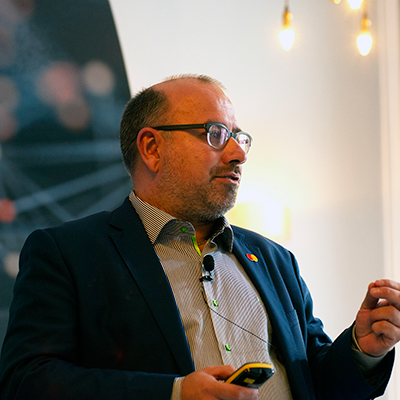Q1. How will customers benefit from Sysdig's recently announced Runtime Insights Partner Ecosystem initiative? What business or security issue is it that Sysdig plans to address via the program?
One unique Sysdig feature is our ability to pull real-time insights from runtime and use them to help make better-informed security decisions across the software lifecycle. No one else comes close to the level of visibility we provide, nor can they match our real-time pace.
The Sysdig Runtime Insights Partner Ecosystem fosters enhanced integration and collaboration between leading cybersecurity solutions so customers can reap the benefits of our real-time runtime insights regardless of their workflow. Sysdig enables ecosystem partners to help security teams prioritize their most critical security issues by focusing on what’s in use. By leveraging this in-use context, such as vulnerabilities and permissions, users can quickly and efficiently home in vulnerability management, posture management, entitlement management, and threat detection and response. In turn, many ecosystem partners provide critical data sources, like cloud, identity, and git logs, that enable Sysdig to detect threats and provide critical cloud security insights across multiple domains.
By partnering with the best of the best, our Runtime Insights Partner Ecosystem enables customers to keep pace with the speed of the cloud. In the last year, we announced AI Workload Security for AWS AI Services, integrated with Snyk AppRisk Pro to quickly and accurately assess runtime vulnerability risk, were named 2024 Google Cloud Technology Partner of the Year for Security, launched an integration for Docker Scout using runtime insights to prioritize risk, and more.
Security is plagued with siloed security tools and fragmented solutions. This initiative provides a cohesive and integrated security approach by linking various security solutions and domains, such as AppSec, threat detection, incident response, identity management, and beyond. A connected ecosystem like the one we’ve built enables faster and more efficient detection, analysis, and response to security threats, outpacing the speed and sophistication of cloud attacks and providing comprehensive protection against threats.
Q2. How exactly are generative AI technologies complicating the cloud security challenge for enterprise organizations? What is it going to take for organizations to mitigate AI risk in cloud environments?
You’re throwing a loaded question at me — where to begin!?
Cloud attacks are fast. The Sysdig Threat Research Team found they can happen in 10 minutes. Think about how quickly 10 minutes can pass. Just as AI and automation unlock greater speed and efficiency for businesses, they’ve become productive “co-pilots” for malicious actors, too. Attackers’ use of AI has significantly improved the speed, number, and success rate of attacks. At the same time, we’ve seen a 33x increase in vulnerabilities in the last eight years and a growing reliance on open source code, and both happening as security bodies’ budgets are being slashed.
While on the one side, AI is aiding the proliferation of threats, the risk of AI workloads themselves is the other side of the AI security coin. The need for greater speed and business efficiency has led to an increased deployment of AI workloads on platforms like Kubernetes. Large language models (LLMs), a core component of GenAI applications, require significant resources and are 35% more likely to be publicly exposed than other workloads. This increased exposure amplifies the risk of security breaches and leaks of an organization’s most sensitive data.
We approach security for AI the same way we’ve approached cloud security: with a focus on what is active in runtime to prioritize true risk and harden security posture proactively. However, organizations must also be realistic. There will be another zero-day vulnerability, perhaps aided by GenAI, so they need the right tools and processes to identify an attack instantly and respond within minutes.
By prioritizing active risks associated with AI workloads and having comprehensive visibility and control over AI deployments, you can mitigate your risk. Sysdig AI Workload Security empowers security teams to identify and prioritize AI workloads, detect suspicious activities, and address vulnerabilities in real time.
Q3. What can customers and other organizations expect to see and hear from Sysdig at Black Hat USA 2024? Do you plan on hosting anything similar to last year's "Honeypot Hack" this time around?
Sysdig will be one of the first things you see when you arrive at Mandalay Bay and pick up your badge — we’re excited to connect with everyone. You’ll also find us in the convention center at booth 1750.
This year we’re laser-focused on demonstrating the value of real-time cloud security and connecting our Threat Research Team with attendees interested in understanding why cloud attacks are different. Sysdig TRT has made groundbreaking discoveries like SCARLETEEL, SSH-Snake, LLMjacking, and more. From harvesting and exploiting AI credentials to a decade-long Romanian botnet outfit, TRT has been uncovering cybercrime and fortifying the Sysdig platform at a remarkable pace. Members of the Threat Research Team will be on-site at Black Hat and look forward to sharing more about their work.
Beyond threat research, we’re excited to talk to attendees about the /555 Benchmark for Cloud Detection and Response and the speed of the cloud. As I mentioned, last year our Global Cloud Threat Report found that cloud attacks were conducted in 10 minutes or less. /555 outlines how quickly organizations should detect and respond to cloud threats — 5 seconds to detect, 5 minutes to investigate, and 5 minutes to respond — and it explores the change in both mindset and process required to meet its demands.
We’re also excited to unveil a few new Sysdig announcements. I won’t give away too much, but among these are: cloud-native investigation and identity security capabilities that empower customers to deliver 5-minute investigations; harnessing the power of AI with Sysdig Sage for threat detection that equips customers to respond in 5 minutes; and updates to the industry’s most comprehensive instrumentation that unlocks complete cloud coverage (including hybrid and multi-cloud environments!).
For the Honey Pot Hack game, I guess you’ll have to stop by the booth to see what we’re cooking.










